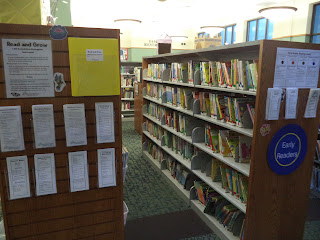 |
| The top shelf displays new titles This is the collection starting at the left end and faces the juvenile dvds |
When I began my current job, over a decade ago, there was a paperback section of the juvenile fiction. Whatever works for other libraries is fine, but I have never liked the idea of collections based on physical format once you get into chapter books. It gets too close to "shelving books by size" out of convenience for the staff with no thought for how patrons look for things. Of course, there are reasons to do it - some people like paperbacks, some books only come in paperback, they can get lost on the shelf, etc. Still, I didn't like the current arrangement.
Over the years, I've refined and shifted this section brainstormed with staff, and finally in the fall of 2021 expanded our early reader and beginning chapter sections and have them in specific areas. All of our beginning chapters are now in one area with the designation JBC and labeled "Branch into Chapters." They combine paperback series in tubs, some hardcovers, easy graphic novels, and stand-alone titles.
 |
| Reading brochures and bookmarks Read and Grow folders |
I previously had extensive lists posted here that included diversity, reading level, and genre and I have now incorporated that into a massive spreadsheet, including series, stand-alone titles, diversity, gender, genre, and reading level.
Interestingly, mysteries used to be the biggest genre and most of our mysteries are older series. Funny series are growing to be the biggest collection and they certainly have a large circulation. Fantasy is a large section, but primarily includes a lot of interchangeable fairies, mermaids, etc. traditionally seen as "girl" books.
 |
| The beginning chapters end in a display of the new juvenile fiction and nonfiction |
Current state of the collection
This collection is currently about 2,000 titles. I have replaced several classic series - Junie B. Jones, A to Z mysteries, and Magic Tree House. I'll continue to expand the beginning graphic novels, as this is a popular trend. I'm still searching for more series with religious themes, titles featuring Hispanic kids, and books with non-white boy protagonists. I'd like to see funny girls and boys (or male characters) who can be magical and sensitive. The only one I've seen so far is in the Fairylight Friends from Acorn. I've added more lower level series, especially Acorn, for the increasing number of struggling readers.
Resources
This collection is currently about 2,000 titles. I have replaced several classic series - Junie B. Jones, A to Z mysteries, and Magic Tree House. I'll continue to expand the beginning graphic novels, as this is a popular trend. I'm still searching for more series with religious themes, titles featuring Hispanic kids, and books with non-white boy protagonists. I'd like to see funny girls and boys (or male characters) who can be magical and sensitive. The only one I've seen so far is in the Fairylight Friends from Acorn. I've added more lower level series, especially Acorn, for the increasing number of struggling readers.
Resources
1 comment:
Wow, Jennifer. That is some great research!! I thought mysteries were still the top. Guess not.
I would bet there are some publishers who would love to see your conclusions - more boy protagonists of color, more Latino/Latina characters.
Great stuff!
Post a Comment